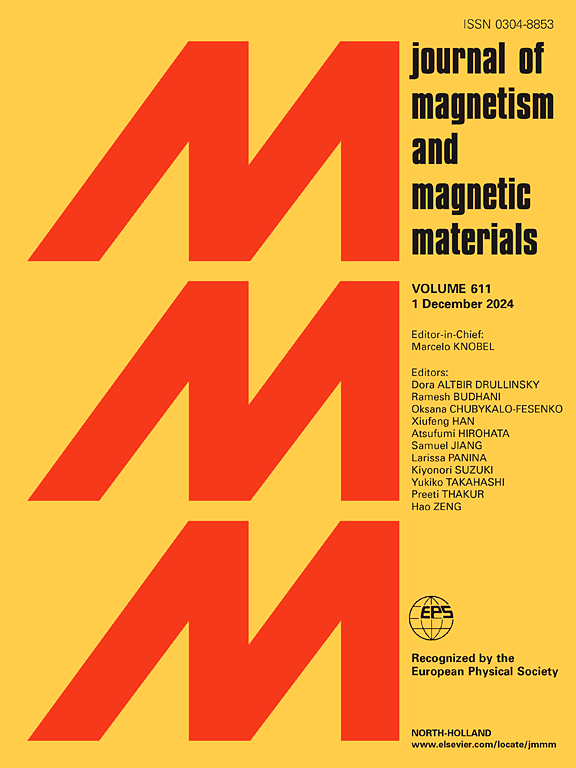压力对α″-Fe16N2结构、磁性、动力学和力学性能的影响
IF 2.5
3区 材料科学
Q3 MATERIALS SCIENCE, MULTIDISCIPLINARY
引用次数: 0
摘要
α″-Fe16N2化合物的基态性质已经得到了深入的研究,但其在高压下的物理性质尚不清楚。本文从第一性原理计算出发,系统地研究了压力对α″-Fe16N2结构、电子、磁性、力学和动力学性能的影响。在0 GPa下的理论结果与以往的理论和实验值一致。铁磁崩溃的临界压力约为61.2 GPa。铁原子在4d和4e位置的磁矩分别最大和最小。Fe矩主要来源于dz2和dx2-y2电子的自旋极化。从声子谱上看,α″-Fe16N2在PC下表现出动态稳定性,且在高压下三个位置的Fe原子表现出不同的振动各向异性。根据B/G和泊松比,Fe16N2在PC层下表现出良好的金属延展性。弹性模量随压力增大而增大,但在临界压力附近软化。此外,弹性各向异性在临界压力PC附近也发生了突变。本文章由计算机程序翻译,如有差异,请以英文原文为准。
Effect of pressure on the structural, magnetic, dynamical and mechanical properties of α″-Fe16N2
The ground-state properties of the α″-Fe16N2 compound have been thoroughly studied, while its physical properties under high pressure are unknown. Here, the effect of pressure on the structural, electronic, magnetic, mechanical and dynamical properties of the α″-Fe16N2 are systematically investigated from the first principles calculations. The theoretical results at 0 GPa are consistent with previous theoretical and experimental values. The critical pressure of ferromagnetic collapse (PC) is about 61.2 GPa. The magnetic moments of the Fe atoms at 4d and 4e sites are the largest and smallest, respectively. The Fe moments are mainly derived from the spin polarization of the dz2 and dx2-y2 electrons. From the phonon spectra, the α″-Fe16N2 exhibits the dynamic stability below the PC, and the Fe atoms at the three sites show different vibrational anisotropy under high pressure. According to the B/G and Poisson’s ratios, the Fe16N2 exhibits excellent metallic ductility below the PC. The elastic modulus increases with pressure, but softens near the critical pressure. In addition, the elastic anisotropy also mutates near the critical pressure PC.
求助全文
通过发布文献求助,成功后即可免费获取论文全文。
去求助
来源期刊

Journal of Magnetism and Magnetic Materials
物理-材料科学:综合
CiteScore
5.30
自引率
11.10%
发文量
1149
审稿时长
59 days
期刊介绍:
The Journal of Magnetism and Magnetic Materials provides an important forum for the disclosure and discussion of original contributions covering the whole spectrum of topics, from basic magnetism to the technology and applications of magnetic materials. The journal encourages greater interaction between the basic and applied sub-disciplines of magnetism with comprehensive review articles, in addition to full-length contributions. In addition, other categories of contributions are welcome, including Critical Focused issues, Current Perspectives and Outreach to the General Public.
Main Categories:
Full-length articles:
Technically original research documents that report results of value to the communities that comprise the journal audience. The link between chemical, structural and microstructural properties on the one hand and magnetic properties on the other hand are encouraged.
In addition to general topics covering all areas of magnetism and magnetic materials, the full-length articles also include three sub-sections, focusing on Nanomagnetism, Spintronics and Applications.
The sub-section on Nanomagnetism contains articles on magnetic nanoparticles, nanowires, thin films, 2D materials and other nanoscale magnetic materials and their applications.
The sub-section on Spintronics contains articles on magnetoresistance, magnetoimpedance, magneto-optical phenomena, Micro-Electro-Mechanical Systems (MEMS), and other topics related to spin current control and magneto-transport phenomena. The sub-section on Applications display papers that focus on applications of magnetic materials. The applications need to show a connection to magnetism.
Review articles:
Review articles organize, clarify, and summarize existing major works in the areas covered by the Journal and provide comprehensive citations to the full spectrum of relevant literature.
 求助内容:
求助内容: 应助结果提醒方式:
应助结果提醒方式:


